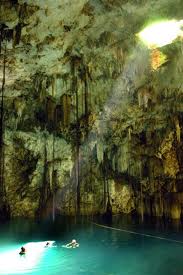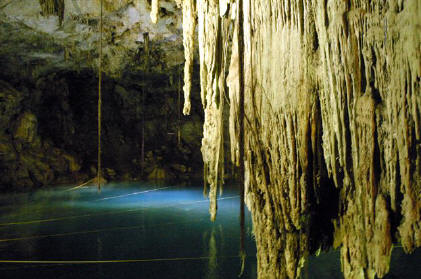Cenote Dzitnup

(Dzitnup is the common name used because of its proximity to the town of Dzitnup)
X’Keken
(Mayan) Pork
A cenote is an underground body of fresh water that has formed under the porous limestone layer of earth. Rainwater quickly seeps down through this layer and is captured below the earth’s thin surface. It is estimated that the Yucatan has over 6000 cenotes and that over 2,400 have been registered.
HISTORICAL NOTES
Locals say that a pig would return to the village from the bush appearing muddy and wet even in times of drought. The residents followed it and discovered the cenote near the town.
(Note: In 1988 when I visited this cenote, the ticket vendor showed us some petroglyphs inside the cave. We have since tried to find them with no luck. If memory serves me well, when you walk down to the central flat area of the cenote, there was a small portal at the back wall away from the pool. You had to climb back in the same direction as the entrance way to a small entrance area. Here there were primitive paintings. I have not read or heard of them again in research or study.)
Mesoamerican cultures revered caves and cenotes, believing them to be the passageway to the underground spirits and deities. Caves were sacred places and Gods of creation and death lived here. In many cenotes offerings of precious metals, stones, shells and human remains have been found, presumably to ask for the Gods favor.
LOCATION & DESCRIPTION
Geographic Location
Cenote Dzitnup is located near the town of Dzitnup on the Yucatan Peninsula in Mexico. It is 3 KMs from the city of Valladolid.

Map
Entrance
There is now a major entrance and parking lot across the road from the cenotes. Here you will be charged 57 pesos admission to enter X’Keken or 57 pesos for Cenote Samula. There are washrooms at the ticket entrance but there is no place to store your valuables.
There are stalls that sell snacks, trinkets and souvineers around the entranceway.
STRUCTURE DESCRIPTIONS
You enter the cenote and walk down the steep wet stairs into the cave. A rope handrail is sometimes available. Once at the bottom you will see the pool of crystal blue water illuminated from the hole above. It is nature’s marquee light, showcasing, featuring the star of the attraction; the cool clean water.
Stalactites and vegetation hang from the roof, Small bats fly to and fro. Magical.
There are numerous rocks and ledges leading down to the water’s edge. Here you can strip down to your swimsuit and leave you belongings of a ledge to the side. At least one – but usually two ropes span the pool of water. You can swim, hold onto the rope or in fact sit on it if you choose. You will enjoy the refreshing temperature of 25.5 C (78° F ) degrees after a hot Yucatan day.
You can see black and white fish in the clear waters, and the approach you and kiss your skin as you soak in the temperate waters. They are said to have become blind living in the darkness for many generations.
This is a perfect opportunity to cool off and reflect after a visit to the pyramids. It is a tranquil peaceful experience.
HOURS
Open Daily from 8 am to 4:30. Allow at least an hour to swim and enjoy the cool air.
RECOMMENDATIONS
The inside of the cave is wet and slippery. Wear rubber soled shoes. Change into your swimsuit at the washroom located at the ticket area.
Take a knapsack to carry a towel and camera. Have a large waterproof baggie to store your camera inside the backpack.
GETTING THERE
GPS –
Taxi – You can easily arrange a taxi from Valladolid, Check the price before you commit to a ride.
Busses
Tours
Tours and tour buses frequently go to Chichen Itza and then to Cenote Dzitnup or Samula. This is a perfect combination.
Drive from Valladolid:
3 KMs: Take Highway
Personal Notes
Cenote Dzitnup, Yucatan
Sacred Underground
Many years ago Bill and I flew into Cancun and traveled the Yucatan by car. We stumbled across a shack on the road with a sign that read Cenote. For a few pesos we were lead down a tunnel to a pool of water. It was completely dark. Stalactites hung from the ceiling; bats flew overhead. We swam in the cool sacred waters. Our guide told us the fish had grown blind as they had not seen light in many centuries.
One major hole had popped through to the surface land. It provided a spotlight of sunshine down to the pool. We have always remembered that experience but could never find our way back to that one special spot. On our recent trip to the Yucatan we found the place. It is called Cenote Dzitnup and is a 10 minute drive from Valladolid.
Things change.
There is now a large parking lot with young attendants. A boy approximately 10 years old points to his eye and our vehicle. Justine tries to speak Spanish to him. He replies in broken Spanish that he is Mayan and is not sure about those Spanish words.
The parking lot is surrounded by artisans and tourist nick-naks. Postcards and cotton blouses. Key rings and bamboo flutes.
We pay approximately $2 each and are pointed to the large hole at the side of the rock. Now a wire rope was secured to the wall of the cave’s stairwell. Instead of slipping and sliding as we had done 15 years previous, we securely managed to descend into the earth.
It was as beautiful as we remembered and a wonderful experience to share as a family.
The blue waters, still as blue and cold as we remembered. The ancient wall paintings still red and colorful.
There are now guide ropes to lead you to the water and the central light.
Cenotes are underground pools and rivers formed by water seeping through the earths soft limestone crust. The pools of water were important sources of water supply for Mayans and the ancient cities. Magic. Cenotes were the doors to the underworld. This is the place that Chac the Rain God lived.
Things change even more
On our most recent trip, the cenote is now a major tourist attraction with large tourist entry point. You can now purchase tickets to more than one cenote ant an – of course – much inflated price!